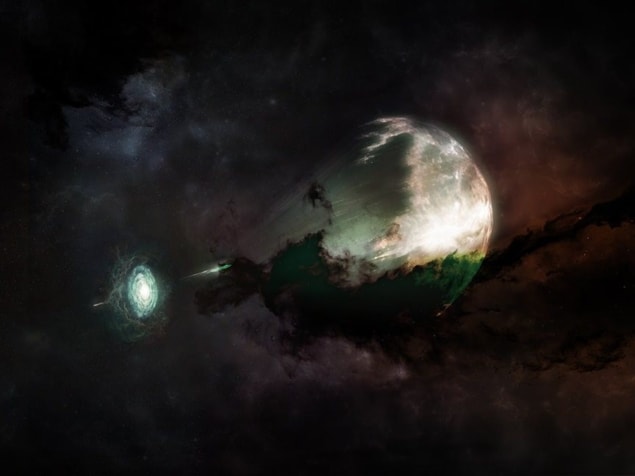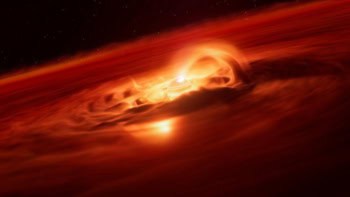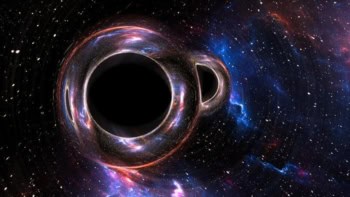
The aftermath of the merger of a neutron star with another star has been observed using millimetre-wavelength light for the first time. The distant merger occurred when the universe was about 5.5 billion years old and was immediately followed by one of the most energetic short-duration gamma-ray bursts (SGRBs) ever spotted by astronomers. It also left behind one of the most luminous afterglows ever seen. These latest millimetre-wavelength observations of that afterglow could help astronomers understand how heavy elements are forged in such cataclysmic mergers.
The SGRB is called GRB 211106A and its gamma-rays were spotted in 2021. Now, Tanmoy Laskar and colleagues have used the Atacama Large Millimetre/submillimetre Array (ALMA) radio telescope in Chile to observe millimetre-wavelength light from the afterglow. In the electromagnetic spectrum, this light falls between the infrared and microwaves.
Explosive mergers involving neutron stars are believed to forge heavy elements like platinum and gold. So, understanding how these mergers proceed is important to understanding how galaxies evolve – and ultimately how heavy elements end up in planets like Earth.
“Very few SGRB afterglows have been detected at radio wavelengths. This is because, although they are very luminous, these explosions take place in distant galaxies, which means the light from them can be quite faint for our telescopes on Earth,” explains Laskar, who will soon join the University of Utah. “Only about half a dozen SGRB radio afterglows are known. And despite almost two decades of searching, none had been detected at millimetre wavelengths.”
Useful emissions
Laskar explains that finding millimetre emissions from an SGRB is particularly useful because the light is unaffected by passing through ionized gas in the Milky Way, something that can make the interpretation of observations of longer wavelength radio waves challenging. Millimetre-light is also immune to the quantum effects that can make the interpretation of high-energy X-rays from distant sources difficult.
Team member Wen-fai Fong, who is at Northwestern University, adds that millimetre wavelengths allow astronomers to “see through” obstructing material that is normally opaque to other wavelengths. “These observations revealed a large amount of dust in the vicinity of this gamma-ray burst,” she adds. “This explains why we did not observe any visible light from the burst.”
Indeed, the combining of observations in varying wavelengths of light was the key to revealing a clearer picture of this powerful event. Northwestern’s Genevieve Schroeder tells Physics World that combining millimetre observations of GRB 211106A with X-ray data showed the team just how energetic and wide the gamma-ray burst was.
Laskar adds, “Learning about these properties helps us better understand the progenitors of these extreme explosions — neutron star mergers”.
Fast moving jets
“When the stars merge, the resulting explosions are accompanied by jets of material moving at close to the speed of light,” says Laskar. “When one of these jets is pointed at Earth, we observe a short pulse of gamma-ray radiation, an SGRB.”
The gamma-ray signal is fleeting – lasting just a fraction of a second – so it is difficult to use a SGRB alone to pinpoint the location of the merger. Fortunately, when the jet strikes gas surrounding the merger, it creates a longer-lasting afterglow that can be seen by astronomers. “Capturing the afterglow light is essential for figuring out which galaxy the burst came from and for learning more about the burst itself,” Laskar explains.
Nevertheless, Schroeder says that the team’s success was not guaranteed. “This observation was the first time we have pointed ALMA at a SGRB, and we were only able to detect the afterglow due to ALMA’s remarkable sensitivity. Previous millimetre observations of SGRBs have resulted in non-detections due to the less sensitive telescopes, so this burst really highlights ALMA’s amazing capabilities.”

Spectacular collision of two neutron stars observed for first time
Because GRB 211106A has been studied across multiple wavelengths as the afterglow faded, Fong says that the team probably will not look at this particular merger with ALMA again.
While gravitational waves have been seen from neutron star mergers, they were not seen from GRB 211106A. This is because the signal would have been too faint for existing gravitational-wave detectors to observe. However, Fong points out that future generations of gravitational wave detectors will soon be able to detect mergers as distant as GRB 211106A.
“That will be a really exciting era, as it will become routine to detect SGRBs in tandem with their gravitational waves.”
The team’s findings are described in a paper on arXiv. The paper has been accepted for publication in The Astrophysical Journal Letters.



